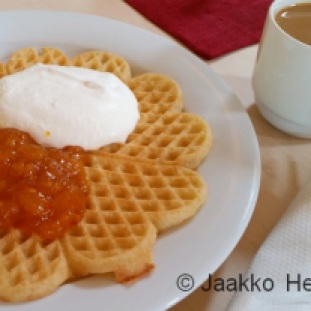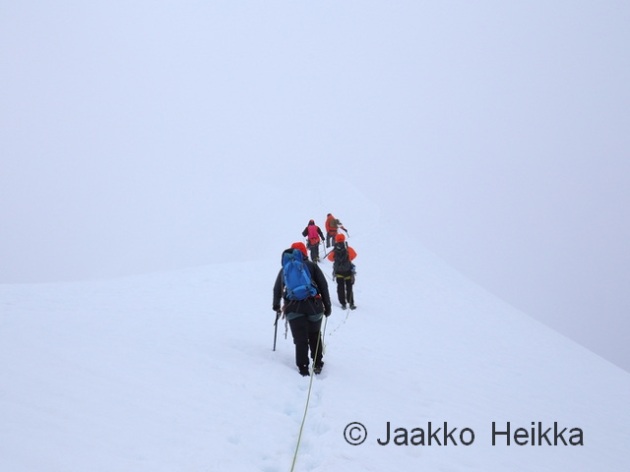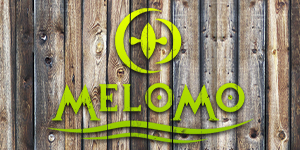In July I spent (again) a week on Kebnekaise area, this time combining two trips into a one-week tour. Both were traverses of a sort, the first including a traverse of the Kebnekaise summits and the second traversing the whole massif with packrafts. This post is about the latter.

The second part of the tour started after the third pint at the Fjällstation. The foundations of the trip being layed in the form of a pitched camp seven kilometers up to the Tarfala valley. So, fueled with the few pints me, Nina and Thomas started the walk back up to the alpine valley. With light packs it didn’t take too long. To lighten my load even further, I had left my rain gear in the camp so when the drops started to land on our shoulders, I sprinted to the camp while N and T stopped to put on their waterproofs.

After a midnight dinner it was time to hit the sack. We were little worried about Thomas’ hand which was slightly swollen and clearly very sore. But with the combined wisdom of two qualified WFRs we came to conclusion that nothing was likely broken and thus it didn’t need urgent attention and some “vitamin i” would suffice.
It wasn’t raining when we woke up but the rain started again while we were packing. And based on the weather forecast, it would rain heavily for the whole day. Good for the packrafting but less so for the walking. We hiked up the Tarfala valley, past the glaciers crawling down between the peaks hiding in the clouds. The end of the valley looks almost impassable but there is a decent path on the moraine ridge next to the Giebmebaktiglaciären.

As we ascended up from the valley the rain crew heavier and the wind picked up. Temperature was probably closer to 0°C than +5°C and with the wind-driven rain it would be a cold day. Before the pass there was a section of steep snow and having changed our boots, crampons and iceaxes to trail runners and paddles had to make due with what we had and be carefull not to take a long tumble-down into the glacial lake.
Up on the pass above 1400m it was even colder and we were soaked. I started to lose grip strength from my fingers, a typical thing for me in the cold, having to do chores by pushing my palms together instead of pinching with my fingers. I wanted to get down fast but N was starting to feel hypothermic and wanted to have a break instead. Luckily someone had cleared a small relatively spot for a tent between the rocks so we decided to have a proper break, pitched our tent and dived inside.

Sheltered by the thin nylon walls, me and Thomas added a layer and N changed into her dry sleeping clothes and drysuit, which was probably the smartest thing to do. Sitting in the tent battered by rain and gusts we watched walls flap and bellow and the little streams rush through the vestibule while enjoying our hot drinks and lunch. But once the stove was off, it wasn’t too warm in the tent either so it was time to get going.
Strengthened by the extra calories and layers we continued down in the steady rain through the land of snow and still partially frozen lakes. The terrain was mostly rocky but the long snow patches offered fun variation in the form of fast slides down, breaking and steering with the mid-sections of our four-piece-paddles. I’m sure the views from Guobirvaggi would’ve been great with decent weather but now we saw only the lower sections of the dark cliffs towering up towards the sky and occasional glimpse of the sharp summit of Gaskkasbakti.
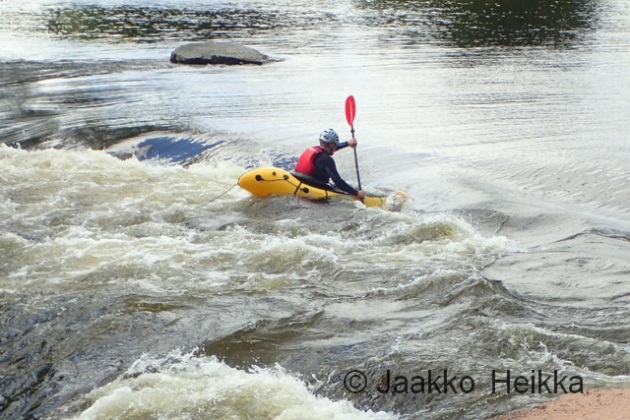
After wading a fast flowing glacial river fattened by the rain we got to easier ground. I ate the last bar of the day to get sensation back to my cold feet and enjoyed the easier walking as rocks started to give away for tundra. Since we started late, we reached the Kungsleden around 20:00 and had to make a decision: camp near the Kuoperjåkka shelter or hike additional 7 kilometers upstream to Sälkastugorna huts. We could see several tents near the little shed downstream and there would be soft dry beds, a little shop and even sauna at Sälkastugorna so the decision was pretty easy.
We hiked up to the hut in 1 hours 40 minutes on the Kungsleden, one of the most famous trails in Scandinavia and thus very worn too. Unfortunately we weren’t fast enough to get to the sauna which was closed at 21:00 but cans of cola and warm dry beds felt about as good. When hanging our gear to dry I emptied half a cup of water from each of the chest pockets of my shell jacket. So much for waterproof zippers!
Knowing that there was also a liter or two of water in our tent from the lunch break, the dry and warm bed felt especially good.
I guess we all felt little beaten the next morning. We lied in long and watched other people come and go preparing breakfast and desperately waxing their 1000G trousers over the gas stove. After a breakfast and final cups of coffee we headed out dressed in our paddling clothing. Me and N had light Ursuk MPS drysuits while Thomas had opted to go with a thin wetsuit. I guess it’s quite rare to have people walking along the Kungsleden in full neoprene suit…
After a short walk to the river we inflated our rafts, scouted the river from a nearby hill and hit the waters of Tjäktjajåkka. Now the extra 7 kilos lugged over the mountains started to do the work and pay back. The river started with a section of rocky class 2 water with a couple of bigger waves but soon calmed down into fast and straight-forward class 1 ride.
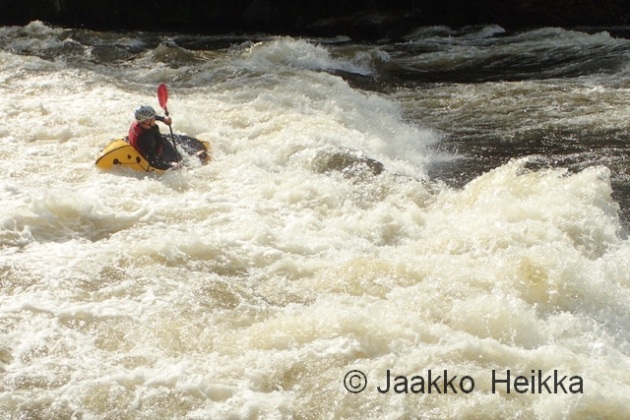
At the first reindeer fence we got out and scouted the canyon-like S curve leading to a little bridge. N and Thomas decided to portage it while I paddled it without the rucksack on the bow. I’d estimate it was around class 3 due to big waves and thigh turns with a neat narrow gate in the end. Very beautiful spot along a river with great views.
It was cloudy with light showers of rain but great weather compared to the day before. Paddling was easy, fast and enjoyable. Very nice packrafting indeed. The MRS Alligator 2S performed well and the dry spray deck and excellent thigh straps were worth the extra kilo.

Closing into the next bridge we knew it was time to get out from the waters and portage based on the aerial photos on Lantmäteriet map service. The beginning looked like fun class 2-3 drops and waves but soon the river rushed into a deep, steep and narrow canyon suitable only for the maddest hard-shell white-water enthusiasts. We had a nice lunch break by the side and portaged along the Western shore past the waterfalls near the Sami village of Kårtjevuolle.
I played around a bit in the final drops enjoying another incredibly beautiful spot. This is how rivers should look like! But soon it was time to continue downstream.
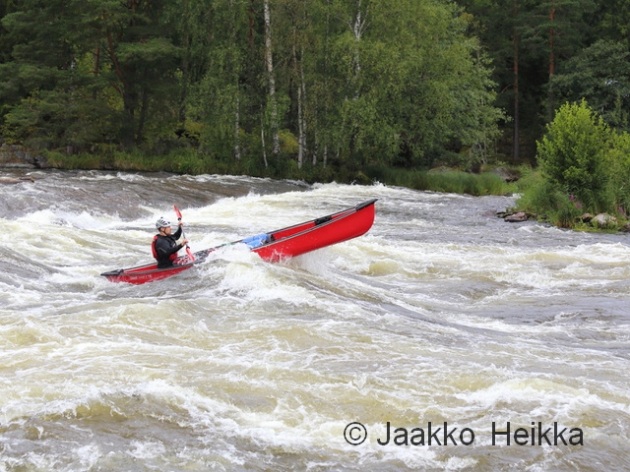
At the end of the previous day we had scratched our original plan of packrafting all the way down to the Padje Kaitumjaure, then following the lake to East and bushwhacking over the fjells to Laddjujohka to paddle down to Nikkaluokta. After the long and wet day it felt like little too much. So instead we took out near the Unna Jiertas fjell and called it a day. There were many gravel banks suitable for camping and quite a bit of dry willow branches cut by the winter ice and left up to dry by the floods. This all translated into good camping grounds for packrafters.

We pitched our tent, spread our gear all over the place to dry in the wind and I bolted out to gather some dry branches for a campfire. For me, an evening by a campfire is essential part of a good packrafting adventure. Unfortunately it started to rain soon and instead of a nice evening by the fire, we spent it in our tent. But the tent and our gear was mostly dry so no real reason to complain.
The next morning we packed our still dripping wet rafting kit into our rucksacks and headed up to the trail towards the Kebnekaise Fjällstation. Despite the clouds, the views down to massive Tjäktavagge valley and around the alpine-like Jierttajavri lake were beautiful. The weather was the familiar mix of cloudy and windy with showers of rain but after the one very wet day, it didn’t feel too bad. Walking on the trail was pretty easy and driven by the promise of hot sauna and cold beer, we hiked the 15 kilometers in four hours or so with very few breaks.
In the afternoon we were again at the Fjällstation. We hadn’t planned it that way but it was welcome. Short and easy day, good coffee and sandwiches on soft sofas and sauna with a cold beer. Not too bad. I felt I could get used to doing trips like that. But not to take it too far, we opted not to have the three-course buffet dinner and also slept in our tent instead of the soft beds. In the late evening the temperature dropped to +4°C but we were warm crammed in our cozy little tent. The Anjan 3 is better for two but works also for three as planned.
Waking up to a cold but sunny dayfor an early start we got distracted by the excellent breakfast at the Fjällstation once and for all and sat there for an hour making up the calories lost during the previous days and downing several cups of good coffee. We were again dressed in our paddling gear and I’m sure many of the fellow guests would’ve liked to ask from the neoprene-clad Thomas what he was up to but politely refrained.
From the distance it had seemed that with the high water we could start paddling almost straight down from the Fjällstation so we walked about a kilometer down to the river. Here the river was more like a stream but seemed paddlable, rocky and fast but not impossibly shallow, so we inflated our rafts one final time and shot down the stream.
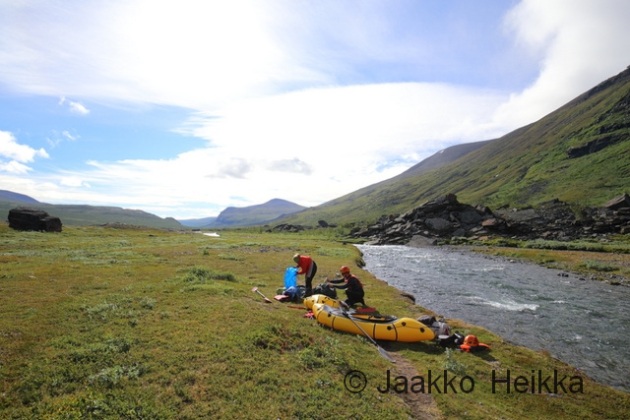
The river stayed small, shallow and fast down to the confluence of the Darfaljohka. It was difficult to avoid all the rocks but good paddling was rewarded with fast and splashy ride without getting stuck on the rocks. Down from the confluence the stream grew into milky.-coloured creek with occasional simple splashy class II sections. Simple and fun going!
Before Laddjujavri lake the river calms down into meandering bends with slow flow requiring a bit of actual paddling. We arrived to the little lake with an excellent backwind and decided to take a lazy ride sailing instead of paddling. I had thought about it already on the way and soon we had lashed our three packrafts side by side and rigged the tent fly to the front as a sail. Me and Thomas, sitting on the side, managed the sail while N was using her paddle as a rudder steering the raft. It worked really well! The lake is only about 2 kilometers long so paddling might had been more efficient time-wise, but this was more fun. We sailed straight to the shore where the locals offer boat rides for tourists to rest their feet and I’m sure baffled a few people again. But still, no-one dared to approach us. Next time, I’ll take a pirate flag too and see how it goes…

On the shore there is the legendary Lap Dånalds which was now closed and superseded by “Restaurang Enoks”. Judging from the upgrade, the reindeer burger business is doing well. Once again we surrendered for the temptations, walked in and offered the whole shebang: reindeer burgers, Cola, waffles and coffee. And oh boy, it was good again!
From the lake the nature of the river changes: It’s more like a proper river than a creek. With this water-level it was was almost a single constant class II rapid for the final five kilometers. The riverbed was littered with boulders from the size of a bucket up to size of a big refrigerator, there was often sweepers in the outer bends and occasional thigh S curve when the milky water had found a new way through a gravel bar. We went down eddy-hopping a section at a time me leading the way. During a longer more demanding section I got worried about how N would do and tried to stop mid-stream to have a look. Instead I hit a rock and capsized. Luckily I only hit my knee and was able to self-rescue easily in the shallow water. A stupid mistake reminding me that paying attention to the river is always primary and other worries secondary.
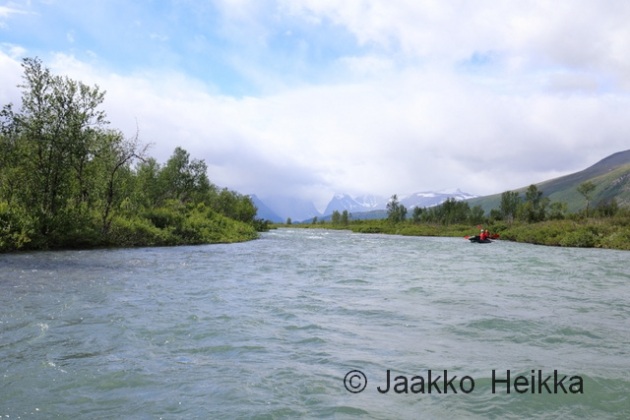
Near Nikkaluokta we arrived once again to a reindeer fence and got off from the river. This time it was not to portage around a dangerous section but for the final short walk and wade to our car which was waiting near the helipad. Six hours after launching our rafts we had paddled 19 kilometers down to Nikkaluokta. With stomachs still full of burgers and other treats we loaded the car and started the long drive South.

The latter part of the trip didn’t go quite as planned but was very enjoyable, maybe except for the wet and cold first day. Should the weather been better we might have done the loop as planned but then we would’ve missed quite a bit of the paddling from Laddjujohka, which was great fun. But I guess I’ll have to return there again one day to explore the lower Tjäktajåkka and many other interesting looking rivers. There’s a lot to paddle on the area!
A word about the rivers near Kebnekaise:
The rivers on the Kebnekaise area are mountain rivers with some creek-like sections. The water-level can change rapidly and you need reasonable level to make good packrafting. See for example SMHI Vattenweb for simulated flow estimates. Based on the Vattenweb we had over 20 sqm/s at the put in of the Tjäktjajåkka and little less at the lower Laddjujohka. Thanks to the heavy rain, both rivers were clearly above the normal summer level. Probably half of the flow would be enough for good packrafting and more might make it challenging in places. I would recommend going earlier in the season to catch the end of the spring flood or waiting for rain to get proper flow. Anyway, one should pay attention to the planning and make sure to avoid the seriously dangerous sections (consult aerial photos for that) and if planning to do whitewater, have the proper gear, skills and company.
The scenery is magnificent, the rivers are beautiful and the packrafting is fun, but remember to be careful!
Jaakko Heikka - Professional wilderness guide and diehard outdoor enthusiast with a special interest for lightweight backpacking, arctic expeditions and outdoor photography.











































